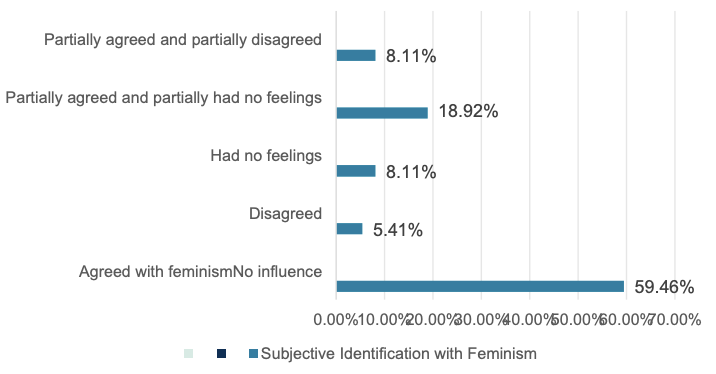

Volume 16 Issue 8
Published on October 2025
This study investigates the impact of influencer credibility, i.e., attractiveness, expertise, and trustworthiness, on consumers' attitudes toward impulse buying in livestreaming commerce. Based on the Theory of Planned Behavior, we examine the effects of attitude, subjective norms, and perceived behavioral control on consumers' impulse buying behavior in the livestreaming environment. The results show that influencers' attractiveness and trustworthiness positively influence consumers' attitudes toward impulse buying in livestreaming commerce. In addition, attitudes and subjective norms significantly affect consumers' impulse buying behavior, while perceived behavioral control is a key antecedent of consumers' impulse buying in live streams. Finally, this study offers important insights for marketers and decision-makers.

 View pdf
View pdf



In recent years, "feminism" 's concerned by the public have been increasing. However, limited research focused on gender differences, around Beijing high school students. So this study aims to focus on this topic. To better understand the research topic, the researcher used a Mixed-methods research design. The researchers first designed a questionnaire and then conduct a short interview with few high school students in order to find out the gender difference they have with feminism. The research found that there were certain differences between females and males in basic concept understanding and also views on social influence. Besides, the result shows that these differences are related to both family attitudes and social media opinions. The research can help change our understanding of teenager gender concepts, also social cultural cognition, and has significance for educators and social scientists.

 View pdf
View pdf



In the past decade, numerous urban planners and architects have sought to construct public spaces from scratch by applying a suite of urban design theories, strategies, and established disciplinary frameworks. However, these principles are rooted in professional designers’ perceptions of 'quality spaces,’ resulting in insufficient attention to local residents’ actual needs and their understandings of what constitutes a 'vibrant place’. Christopher Alexander argues that 'we are better off growing good places and spaces, rather than trying to build them from a blueprint’. This implies that high-quality public spaces must align with local contexts—including local vegetation, the natural environment, and residents’ preferences. Therefore, the objective of this research is to explore the key elements that contribute to creating vibrant public spaces in Sheffield. By summarising and synthesising these elements, the study further aims to propose evidence-based recommendations for the development of local public spaces. The thesis is structured into three chapters: Chapter One discusses the necessity of public spaces and defines the concept of 'vibrancy’; Chapter Two outlines the research model and methodology adopted to address the core research question; Chapter Three identifies key factors contributing to vibrant public spaces in Sheffield through the analysis of four representative sites.

 View pdf
View pdf


A prevailing consensus in education laments the role of shadow education as a significant driver of social inequality, a concern that prompted China’s recent regulatory policies aimed at inhibiting its growth. However, this well-intentioned policy exacerbated existing gaps as they grant privileges to families with more economic and cultural capital. Drawing on Bourdieu’s capital theory, this study employs thematic analysis through semi-structured interviews with 17 participants from diverse socioeconomic backgrounds to explore the complex motivations for participating in shadow education in China and its impact on educational equality. The findings reveal the tension between passive conformity with competitive social norms and active pursuit of social mobility, reflecting broader contradiction between elite ideology and structural inequality. Rather than merely suppressing shadow education, the government should emphasize the value of education for the common needs of all stakeholders, thereby alleviating existing structural inequalities.

 View pdf
View pdf



Senior high school arts curriculum is an important carrier for implementing aesthetic education and ideological and political education. Leveraging its advantages in multimodal information perception, generation, and analysis, artificial intelligence systematically elucidates the evidence-based mechanisms and practical strategies by which it empowers ideological and political education in senior high school arts courses across three dimensions: innovation of instructional content, reconstruction of the teaching process, and deepening of instructional assessment. This provides a new pathway for constructing “evidence-based” arts ideological and political education, aiming to steer arts-based ideological and political work from experience-driven practice toward scientific evidence, and from uniform instruction toward personalized cultivation, thereby achieving an overall enhancement of educational effectiveness.

 View pdf
View pdf


Joint cultivation of postgraduates by universities is an important mechanism to promote inter-university resource sharing and improve the quality of postgraduate education, involving the optimal allocation of internal and external educational resources and the innovation of talent cultivation models. It can help relevant universities connect with high-level platforms in terms of team co-construction and resource sharing, facilitate disciplinary intersection and complementary advantages to promote academic output, enhance universities' disciplinary competitiveness through scientific research cooperation or disciplinary intersection, and cultivate postgraduates' practical abilities to improve their employment competitiveness. Therefore, through an empirical analysis of the paths, problems, and effectiveness of joint cultivation, this study further clarifies that constructing diverse mechanisms, co-building disciplinary platforms, deepening resource sharing, realizing disciplinary intersection, and improving evaluation systems are important measures for universities to promote the reform of joint cultivation models and enhance the quality of talent cultivation.

 View pdf
View pdf


This paper examines the copyright challenges raised by generative artificial intelligence (“AI”). It begins by analyzing the generative process, arguing that the originality of text prompts can serve as a basis for the copyrightability of AI-generated outputs. Accordingly, the study then explores the complex issue of attribution based on the proposed generative process, evaluating the competing claims of users, developers, and data providers, and proposes an ownership model that reflects the degree of creative contribution. Finally, the paper addresses infringement concerns, comparing regulatory approaches in the US, EU and China, and advocates a balanced protection framework that reconciles innovation with copyright safeguards.

 View pdf
View pdf



Adolescents’ engagement in Anime, Comics, and Games (ACG) subcultures, particularly through cosplay and conventions, has become a prominent avenue for identity exploration and emotional coping. This study examines how different types of ACG participation—cosplay only (CP-Only), convention attendance only (CN-Only), and combined cosplay and convention engagement (CP+CN)—influence emotion regulation strategies, specifically cognitive reappraisal and expressive suppression, among Chinese adolescents aged 13–18 years (N = 204). Using the Emotion Regulation Questionnaire (ERQ) and a one-way ANOVA with post hoc tests, significant differences were observed across groups. The CP+CN group exhibited lower cognitive reappraisal scores compared to CP-Only (p < .001), suggesting that public role-playing demands may deplete cognitive resources, while their reduced expressive suppression scores (p < .001) aligned with the “safe space” hypothesis, where communal belonging fosters emotional authenticity. Regression analyses revealed that increased cosplay frequency predicted both higher reappraisal (R² = 0.114) and suppression (R² = 0.140) scores, indicating context-dependent regulatory flexibility. Gender imbalance (74.7% female in CP+CN) further highlighted gendered socialization effects on suppression tendencies. These findings underscore the dual role of ACG subcultures: mitigating suppression through peer support while constraining adaptive cognitive strategies under performance pressures. The study advocates for culturally sensitive interventions leveraging ACG communities and calls for longitudinal and neuroimaging research to disentangle causal mechanisms. This work contributes to understanding how leisure activities shape adolescent emotional development, bridging social identity theory with neurobiological perspectives to inform mental health practices in digital-popular cultures.

 View pdf
View pdf


As China has moved to the era of degree involution, many students have chosen to go abroad to pursue further study because of the cost-effective tuition fee and the excellent educational resources. Malaysia has become a preferred option for many students. According to Education Malaysia Global Services (2025) data, Chinese students studying abroad have emerged as Malaysia's most significant international student population. And the adaptation for international students is a hot topic among scholars. This study examines the challenges and factors affecting adaptation for Chinese international students in Malaysia. It addresses language barriers and cultural adaptation, analyzes influencing factors, and proposes practical solutions. Meanwhile, the main research objective will be those oversea students studying in Malaysia who came from China, this study will provide valuable and consultable reference for students who will pursue study in Malaysia and Chinese students studying in Malaysia who is suffering adaption anxiety. Hopefully, this study will also attract attention to the issue of overseas students’ mental health and welfare. The study shows that the language barrier is still the main factor, and students can release their stress by consolidating their language foundation, improving their self-learning ability, broadening their social circle and so on.

 View pdf
View pdf



This study investigates the integration of learning analytics with fairness quantification in formative assessment, with an emphasis on contextualized interventions that respond to inequities in student learning processes. The research adopts a multi-institutional dataset comprising over 4,500 students across 18 classrooms, integrating log files, assessment records, and survey responses to ensure demographic, behavioral, and socio-cognitive diversity. A hybrid fairness quantification model is developed, combining statistical fairness metrics such as equal opportunity and disparate impact ratios with learning analytics indicators, including feedback latency, participation depth, and adaptive engagement. Interventions were designed through a three-layered protocol involving algorithmic detection of inequities, contextual mapping of student profiles, and targeted instructional adjustments. The results show that the fairness gap is most significant in feedback distribution, and the delay has a particularly severe impact on students from less affluent socioeconomic groups. The intervention measures increased the fairness index score by an average of 0.37 points on the standardized 0-1 scale, and the student satisfaction score was 21% higher than that of the control group. The benefits confirmed by the three-semester longitudinal follow-up were consolidated, and the standard deviation of the fairness index decreased from 0.18 to 0.07, indicating greater fairness consistency among the cohorts. Research has found that an analytical framework that emphasizes fairness not only enhances the transparency of formative assessment but also improves scalable, evidence-based intervention measures, thereby bringing about sustainable educational equity reforms.

 View pdf
View pdf




